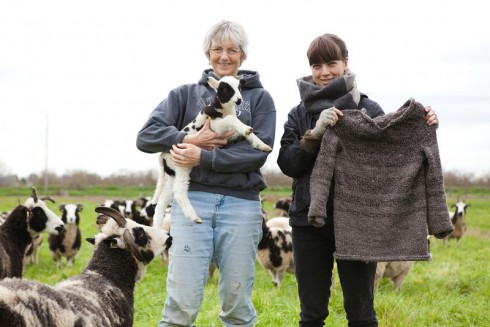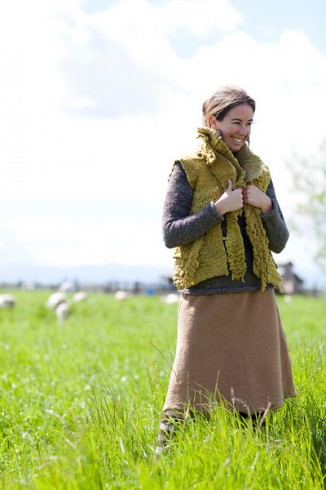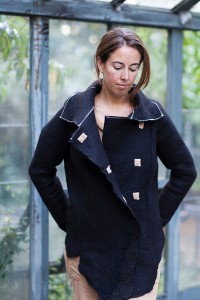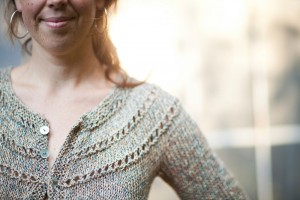Rebecca Burgess is an author, teacher, and natural dye artisan who has worked for over a decade creating recipes from local flora. She teaches natural dye workshops throughout the country to crafters, ecologists, and art students. Rebecca has been a guest lecturer at Harvard University and has consulted apparel companies on how to incorporate natural dyes into their supply chain. She is the founder of Ecological Arts, an organization dedicated to creating, reviving, and teaching functional art forms that utilize natural raw materials.
The current American textile tradition lives on the looms, knitting needles, and spinning wheels of a committed group of artisans—however we rarely see a handcrafted textile on the backs of average Americans.
The mechanization of textile production spawned by the Industrial Revolution was driven by a desire for efficiency as well as the bottom line. Industrial processes increased the availability and abundance of clothing, and yet, to meet increasing demand, the search for cheaper and more exploitable labor did not cease- a pattern which has continued on course for over one hundred years. Today. Now more than 95% of our clothing comes from overseas. We have become dependent upon a faceless, and story-less system that makes little to no reference to its roots.

Robin Lynde of Solano County and Kacy Dapp of Oakland collaborate to make a Fibershed shirt
My response to this massive growth of the textile manufacturing industry began with a series of questions, “Why am I buying wool undershirts from China and New Zealand when we are throwing away our wool here?” and, “Why are there so many unemployed and underemployed people in my community, when it seems there is so much work to be done?” and “Why are we allowing textiles to be the number one polluter of fresh water on the planet, with the fifth largest CO2 footprint in the US?” We don’t even have a textile industry… how can it still be polluting so much?
These questions prodded me to make a series of investigations into the natural fiber and dye potentialities laying rather dormant in this country. I soon realized there is no reason why we can’t be returning the natural fiber and color traditions of our homeland back to our closets.
This re-engagement of an American textile tradition is simply waiting to happen, and it should be our job to define how. With these thoughts in mind, I gave myself a challenge: for a year, I would attempt to source all the necessary fibers and dye plants within 150 miles of my front door to make myself a wardrobe.This project, that I call “Fibershed,” is an attempt to swing the pendulum of production towards something more humane for people and planet.

Rebecca wearing Sue Reuser's Cormo Vest dyed in onion skins made by Sierra Reading, shirt knit by Kacy Dapp with Robin Lynde's wool from Meridian Jacobs and Sally Fox buffalo brown cotton skirt sewn by Kerry Keefe
I had no idea what I was in for… as a weaver and natural dyer, I figured I would just do this myself. I didn’t need to talk about it much, or say too much, the wardrobe would speak for itself. I thought, “I’ll just sit at my loom, and weave myself some fabric, and sew my clothes.” This didn’t exactly turned out as planned.
As I raised funds for the raw materials and as funding solidified, I started making phone calls to the farmers. Within two weeks I had an unexpected cadre of weavers, knitters, designers, and seamstresses knocking on the door, all asking me if they could help.
The project instantly turned into a social network of farmers and artisans. The urban and the rural seemed to be making friends. The fiber and craft communities were beginning to get the attention of product designers who’d enlisted to help me. High end design minded students from CCA, ex-pottery barn employees, and environmental activist knitters were all pining for local fibers… “Let me see the yarns, I want those natural dye colors… there is so much here to work with, I never would have guessed!” was a common sentiment from every designer who came on board.
The Fibershed wardrobe is in its 10th month, and I am happily clothed. I made it through a long winter (that hasn’t seemed to end here in the fog of West Marin). We are now looking at the supply chain seriously—and asking, “How can we get this wardrobe onto the backs of more people?” We are now in the midst of fundraising for Sally Fox (our pre-eminent organic cotton farmer) to have the first solar powered farm based mill in North America. We are studying scale—and realizing more and more how possible this vision is. We are seeking to develop a healthy middle ground between the centralized money driven off-shore manufacturing systems, and the home-scale handwork.

Julie Rosenfeld's alpaca coat felted by Katerine Jolda and sewn by Mali Mrozinski

Heidi Iverson original handknit sweater. Her own pattern on Sally Fox's yarn-one strand dyed indigo
As skilled weaving artisans—Fibershed needs you. This is a team effort, and we need the knowledge base you provide to help stimulate and inform the process of creating fine gauge weaving yarns in our region. We need your voice and your passion to help us build the small scale milling facilities necessary to make something useful with our world-class fibers. We have no shortage of wool, cotton, angora,
cashmere, alpaca, or talent—we seem to just be missing a bit of equipment.
If you would like to take part in the process of getting our community mill off the ground, there are ways in which you can help make this happen. We are in the midst of raising money through an online marketplace. If you are a weaver or an artisan with a good design idea—and want to work with local materials—you might be interested in selling your goods with our 501c3. All money raised from the sale of locally farmed and produced goods will go to you, and to the milling equipment we need to get our Fibershed supply chain humming. We look forward to an enriched textile era—one that supports our farmers, artisans, and local economy.
To read more about our project: http://fibershed.wordpress.com/ Email: harvestingcolor(at)gmail.com
For more information on regional natural dyes and recipes: Harvesting Color by Rebecca Burgess is now available a local bookstores and knit stores as well as online.
For sourcing local fibers,check out The Natural Fiber Fair in Arcata